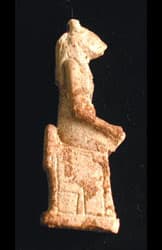New Kingdom Faience Amulet of Sekhmet, 1600 BCE - 1100 BCE
Faience
PF.4420
Further images
This lovely amulet is in the form of a seated statuette of the goddess Sekhmet. This goddess is depicted with the body of a human and the head of a...
This lovely amulet is in the form of a seated statuette of the goddess Sekhmet. This goddess is depicted with the body of a human and the head of a lioness. She was the goddess of disease and pestilence, but could also protect one against them. In mythology she was the spouse of the god Ptah, a creator god as well as god of artists and craftsmen. Their child was Nefertem, a child sun god, who was depicted with a lotus on his head. The name Sekhmet means "powerful (female) one" in the ancient Egyptian language. She was a daughter of the sun god re and protected the king with her powers. The small square in the lower corner of her throne represents the actual seat of the throne. This is a stylistic feature of Egyptian art. This was done in order to show parts of an object normally not visible in two-dimensional art.







